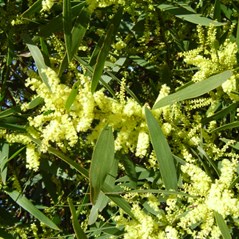Acacia longifolia var. sophorae
Coastal Wattle
Notes
Uses: As a wind-break or screen on wide median strips on highways or in parks and reserves.
Fragrant, bird and insect attracting.
Note: This species is classified schedule 1, Regulation 24.2 under the Sewerage Act and may be planted in any street or road in any drainage area provided they are not planted closer than two metres to any sewer main or connection.
Cultural use: Indigenous peoples roasted and ate the seeds.
This plant is indigenous to the following botanical regions of South Australia.
:EP: Eyre Peninsula
:MU: Murray
:YP: Yorke Peninsula
:SL: Southern Lofty
:KI: Kangaroo Island
:SE: South Eastern
For detail on these regions refer to the user guide
- Height 2-6m
- Spread 4-10m
- Position
- Full Sun
- Part Shade
- Family Fabaceae
- Botanical Name Acacia longifolia var. sophorae
- Common Name Coastal Wattle
- Origin SA, Vic, NSW, Tas
- Habit Dense, Spreading
- Landscape Coast, Coastal dunes, Coastal footslopes, Footslopes, Hills, Plains, 2nd line coast
- Soil Texture Clay, Loam, Sand
- pH Acidic, Alkaline, Neutral
- Tolerates Lime, Moderate frost, Soil salinity, Salt spray
- Supplementary Watering Minimal
- Flower Colour Yellow
- Flowering Time Spring, Winter
- Flower Type Clusters
- Purpose Bush food, Erosion, Habitat, Noise reduction, Screen
- Evergreen/Deciduous Evergreen
- Form Large Shrub (Usually exceeds 3.6m)
- Indigenous to the Adelaide Region







